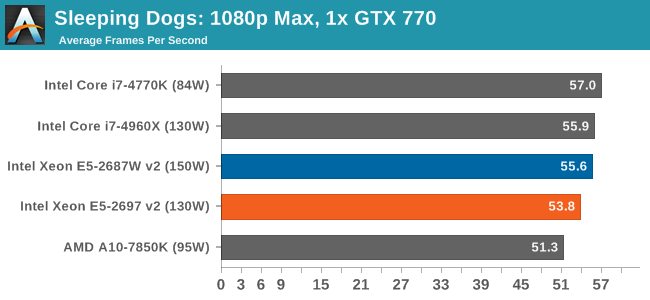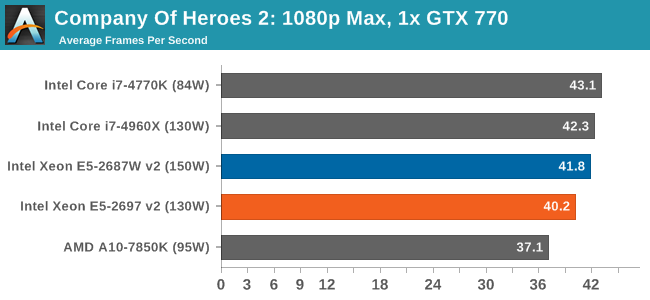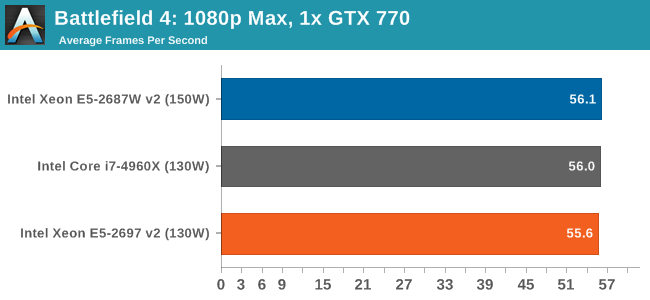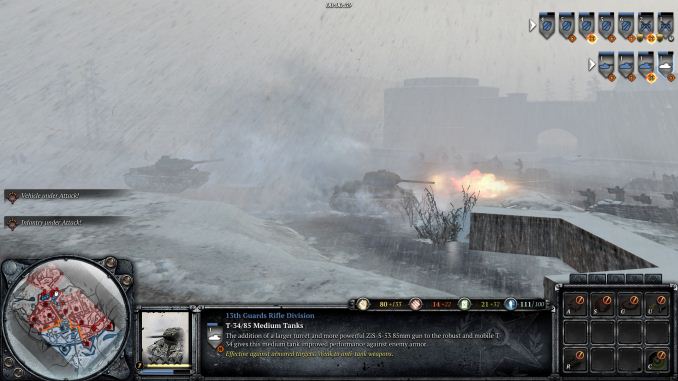Intel Xeon E5-2697 v2 and Xeon E5-2687W v2 Review: 12 and 8 Cores
by Ian Cutress on March 17, 2014 11:59 AM EST- Posted in
- CPUs
- Intel
- Xeon
- Enterprise
Sleeping Dogs
Sleeping Dogs is a benchmarking wet dream – a highly complex benchmark that can bring the toughest setup and high resolutions down into single figures. Having an extreme SSAO setting can do that, but at the right settings Sleeping Dogs is highly playable and enjoyable. We run the basic benchmark program laid out in the Adrenaline benchmark tool, and the Xtreme (1920x1080, Maximum) performance setting, noting down the average frame rates and the minimum frame rates.

| Sleeping Dogs, 1080p Max | ||
| NVIDIA | AMD | |
| Average Frame Rates |
|
|
| Minimum Frame Rates |
|
|
The lower frequency of the 12-core Xeon sometimes puts it behind in our Sleeping Dogs testing, usually in multiple GPU results such as 3x HD 7970 where it is 15 FPS behind both the i7-4960X and E5-2687W v2
Company of Heroes 2
The final gaming benchmark is another humdinger. Company of Heroes 2 also can bring a top end GPU to its knees, even at very basic benchmark settings. To get an average 30 FPS using a normal GPU is a challenge, let alone a minimum frame rate of 30 FPS. For this benchmark I use modified versions of Ryan’s batch files at 1920x1080 on Medium. COH2 is a little odd in that it does not scale with more GPUs.

| Company of Heroes 2, 1080p Max | ||
| NVIDIA | AMD | |
| Average Frame Rates |
|
|
| Minimum Frame Rates |
|
|
COH2 also acts somewhat CPU agnostic, although the higher frequency Xeon does have a small negligable boost over the E5-2697 v2. In all circumstances, the i7-4960X is competitive.
Battlefield 4
The EA/DICE series that has taken countless hours of my life away is back for another iteration, using the Frostbite 3 engine. AMD is also piling its resources into BF4 with the new Mantle API for developers, designed to cut the time required for the CPU to dispatch commands to the graphical sub-system. For our test we use the in-game benchmarking tools and record the frame time for the first ~70 seconds of the Tashgar single player mission, which is an on-rails generation of and rendering of objects and textures. We test at 1920x1080 at Ultra settings.

| Battlefield 4, 1080p Max | ||
| NVIDIA | AMD | |
| Average Frame Rates |
|
|
| 99th Percentile Frame Rates |
|
|
As we add more GPUs, AMD and NVIDIA act differently. With NVIDIA, more MHz gets better frame rates, whereas with AMD more cores wins out.
Conclusions
It would seem that in our gaming benchmarks, the higher frequency E5-2697W v2 is the more obvious choice over the 12-core E5-2697 v2. However in almost all circumstances, they perform on part with or below the i7-4960X, thus suggesting that our games tested cannot take advantage of more threads.












71 Comments
View All Comments
mrnuxi - Tuesday, March 18, 2014 - link
I know you were benchmarking these Xeons for home use, thus the selection of rendering and gaming benchmarks. But there are lots of us doing home virtualization (VMWare ESXi all-in-one servers using PCI-passthrough ZFS virtual SAN and multiple VMs). It would be great so see some virtualization benchmarks. For further reference see: http://www.napp-it.org/index_en.htmlIan Cutress - Tuesday, March 18, 2014 - link
Johan covered the server side in his article -http://www.anandtech.com/show/7285/intel-xeon-e5-2...
alpha754293 - Wednesday, March 19, 2014 - link
No LS-DYNA or other HPC benchmark results??? Talk to Johan.colonelclaw - Wednesday, March 19, 2014 - link
Hi Ian, Thanks for a great review.Do you think there's any possibility of adding V-Ray to your workstation benchmarks? It's an incredibly popular renderer that is multi-platform and also works in pretty much any decent 3D software (Max, Maya, C4D etc). It also sucks the life out of any computer when it's running, so would be perfect for your tests.
Kougar - Wednesday, March 19, 2014 - link
Question. Since you discuss turbo bins at length and the article revolves around them, how does Windows Server handle load balancing in regards to the turbo bins. On a 2P E5-2697 will the OS balance all the threads on a single CPU first? Spread evenly across both CPUs? Max out all physical cores before assigning threads to logical cores?Is the OS capable of spreading 3 threads to each processor to ensure they both run at the max turbo frequency for as long as possible? Or would it instead max out one processor to attempt to let the other retain a lower power state? For that matter is any of this even configurable under Windows Server?
Ytterbium - Saturday, May 3, 2014 - link
Ian, does MCE work with Xeon?Ytterbium - Tuesday, May 6, 2014 - link
MCE doesn't seem to work with Xeon 2687w.RadamanthysBe - Sunday, May 4, 2014 - link
Interresting article, but I dont agree with your conclusion on the 2667 vs 2687w :You say 2667 id cheaper, ok but 50 $ difference in list price on cpu costing 2100 $, that is less than 2%.
You also say 2687w v2 use more energy than 2667 v2, do you have proof of that ? For me the fact that 2687w v2 has a 150w tdp only mean it can keep its turbo frequency under higher load than 2667, with situations where 2667 turbo mode would drop because of the power usage while not on the 2687w v2, making it in fine a faster cpu than 2667 under heavy loads. If the two cpu run the same computation at the same frequency, there is no reason 2687w v2 uses more power, it would be like saying that i5 and i7 consume the same because they have the same tdp, while everybody knows it is not the case.
Ytterbium - Monday, May 5, 2014 - link
I just bought a 2687w v2, it ended up being $3 difference between them, I have i7-3970X so I have 150W chip anyway, so TDP wasn't really much of a factor to me.It would be interesting to do a head to head of them and see how they perform, in thermal load/power.
Following Ian's logic he's be super interested in the E5-2673 v2, this is the same as the 2667 but with 110W TDP.
If the 2690 had a little higher turbo, it would be great, 10/20 with say 3 stock and 3.8 turbo
Ytterbium - Tuesday, May 6, 2014 - link
The 2687 I got seems to run a bit cooler than my 3970X, even though there rated for the same.